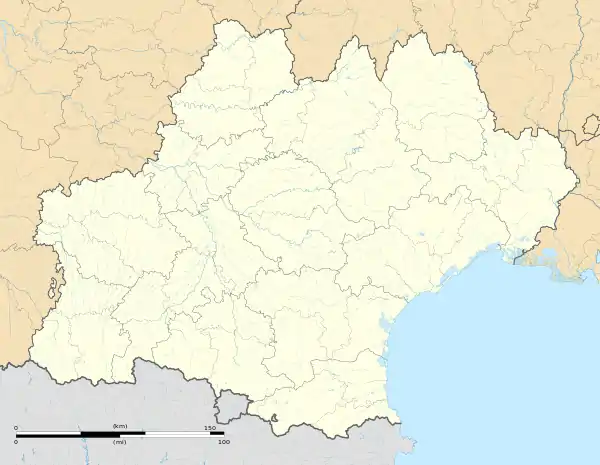Saint-Élix-Séglan | |
|---|---|
Location of Saint-Élix-Séglan | |
 Saint-Élix-Séglan  Saint-Élix-Séglan | |
| Coordinates: 43°11′47″N 0°51′18″E / 43.1964°N 0.855°E | |
| Country | France |
| Region | Occitania |
| Department | Haute-Garonne |
| Arrondissement | Saint-Gaudens |
| Canton | Cazères |
| Intercommunality | Cœur et Coteaux du Comminges |
| Government | |
| • Mayor (2020–2026) | Nicolas Suspene[1] |
| Area 1 | 2.86 km2 (1.10 sq mi) |
| Population | 43 |
| • Density | 15/km2 (39/sq mi) |
| Time zone | UTC+01:00 (CET) |
| • Summer (DST) | UTC+02:00 (CEST) |
| INSEE/Postal code | 31477 /31420 |
| Elevation | 313–401 m (1,027–1,316 ft) (avg. 327 m or 1,073 ft) |
| 1 French Land Register data, which excludes lakes, ponds, glaciers > 1 km2 (0.386 sq mi or 247 acres) and river estuaries. | |
Saint-Élix-Séglan is a small rural village and commune in the Haute-Garonne department in southwestern France. It is best known for the castle which dominates the village.
Geography
The commune is bordered by four other communes: Peyrouzet to the northwest, Aulon to the southwest, Cazeneuve-Montaut to the southeast, and finally by Aurignac to the northeast.
Population
| Year | Pop. | ±% |
|---|---|---|
| 1962 | 85 | — |
| 1968 | 91 | +7.1% |
| 1975 | 69 | −24.2% |
| 1982 | 68 | −1.4% |
| 1990 | 59 | −13.2% |
| 1999 | 47 | −20.3% |
| 2008 | 42 | −10.6% |
Sights
The Château de Saint-Élix-Séglan is a 14th-17th century castle which is listed as a historic site by the French Ministry of Culture in 1991.[3]
See also
References
- ↑ "Répertoire national des élus: les maires". data.gouv.fr, Plateforme ouverte des données publiques françaises (in French). 9 August 2021.
- ↑ "Populations légales 2021". The National Institute of Statistics and Economic Studies. 28 December 2023.
- ↑ Base Mérimée: Château de Saint-Élix-Séglan, Ministère français de la Culture. (in French)
Wikimedia Commons has media related to Saint-Élix-Séglan.
This article is issued from Wikipedia. The text is licensed under Creative Commons - Attribution - Sharealike. Additional terms may apply for the media files.